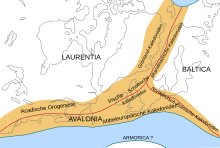Caledonian orogeny



The Caledonian orogeny is the older of the two multi-phase mountain formations of the North American-European Paleozoic . It began in the Ordovician and culminated in the Silurian . "Caledonian" comes from the Latin - Celtic name Caledonia for Scotland .
During this Paleozoic mountain formation, today's rump mountains of the British Isles, partly the Scandinavian basement and - in a broader sense - the Appalachians in eastern North America emerged. The east coast of Greenland, Bear Island , Orkney and Shetland Islands and west Svalbard are also of Caledonian origin.
During the Ordovician - about 450 million years ago - the geological continents Laurentia , Baltica and Avalonia had drifted from high southern latitudes towards the equator . They collided with each other in several phases. The Tornquist Ocean between Baltica and Avalonia and the Iapetus Ocean were closed. The island arches and mountains created during the subduction and closure of the Iapetus Ocean are known today as the Caledonian mountains, the associated or underlying mountain formation as Caledonian orogeny.
development
The exact course of these collisions in the period is not known in detail. The following sequence is considered likely:
- Avalonia first collided with Baltica in the High Ordovician . It is believed that Avalonia formed a volcanic island arc before it collided with Baltica.
- An island arch formed off the east coast of Laurentia, under which the Iapetus was subducted .
- The Iapetus was completely closed in the Silurian . The Irish-Scottish Caledonids and the Scandinavian Caledonids emerged in several phases. The arch of the island off the east coast of Laurentia was folded into the Appalachians. This branch continues on the east coast of Greenland to Spitsbergen and Bear Island. The Appalachians originated in North America . A new major continent - Laurussia or Old Red continent - emerged.
literature
- L. Robin M. Cocks, Trond H. Torsvik: European geography in a global context from the Vendian to the end of the Palaeozoic. In: David G. Gee, Randell A. Stephenson (eds.): European Lithosphere Dynamics (= Memoirs of the Geological Society of London. Vol. 32). Geological Society, London 2006, ISBN 1-86239-212-9 , pp. 83-95.
- Jane A. Plant, Alfred Whittaker, Alecos Demetriades, Benedetto De Vivo, Jaroslav Lexa: The Geological and Tectonic Framework of Europe. In: Geochemical Atlas of Europe. Volume 1: Reijo Salminen (Ed.): Background Information, Methodology and Maps. Geological Survey of Finland, Espoo 2005, ISBN 951-690-921-3 , pp. 23-42, online (PDF; 731 kB) ( Memento of May 4, 2007 in the Internet Archive ).
